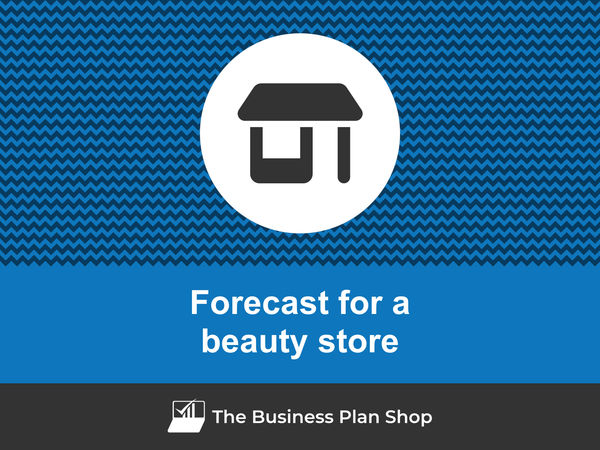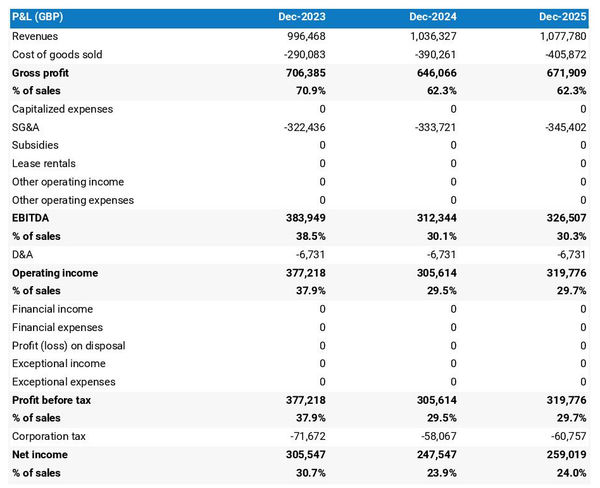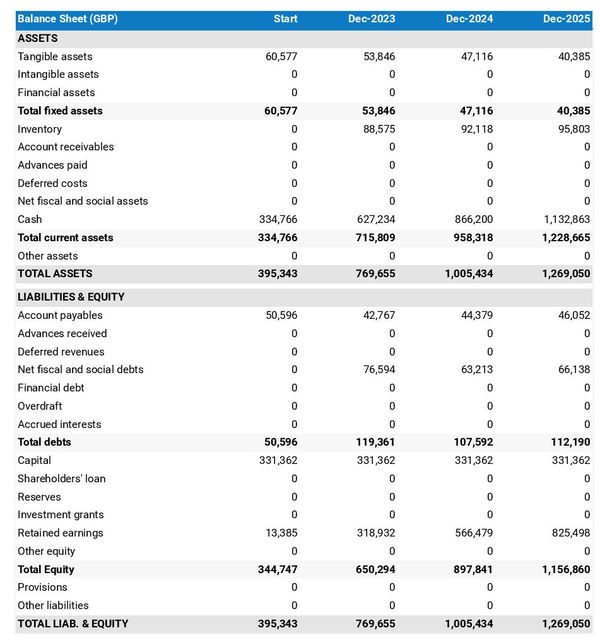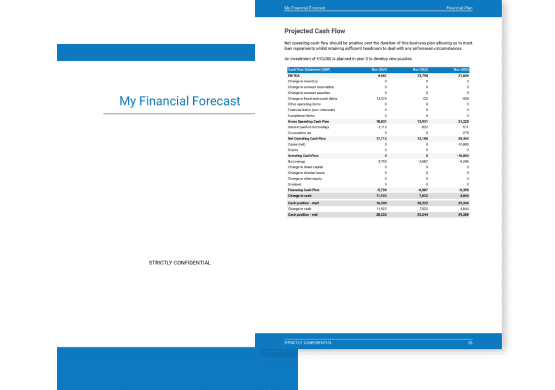How to create a financial forecast for a beauty store?

Creating a financial forecast for your beauty store, and ensuring it stays up to date, is the only way to maintain visibility on future cash flows.
This might sound complex, but with the right guidance and tools, creating an accurate financial forecast for your beauty store is not that hard.
In this guide, we'll cover everything from the main goal of a financial projection, the data you need as input, to the tables that compose it, and the tools that can help you build a forecast efficiently.
Without further ado, let us begin!
Why create and maintain a financial forecast for a beauty store?
The financial projections for your beauty store act as a financial blueprint to guide its growth with confidence and ensure its long-term financial viability.
To create them, you will need to look at your business in detail - from sales to operating costs and investments - to assess how much profit it can generate in the years to come and what will be the associated cash flows.
During challenging market conditions, maintaining an up-to-date financial forecast enables early detection of potential financial shortfalls, allowing for timely adjustments or securing financing before facing a cash crisis.
Your beauty store's financial forecast will also prove invaluable when seeking financing. Banks and investors will undoubtedly request a thorough examination of your financial figures, making precision and presentation essential.
Need a solid financial forecast?
The Business Plan Shop does the maths for you. Simply enter your revenues, costs and investments. Click save and our online tool builds a three-way forecast for you instantly.

What information is needed to build a beauty store financial forecast?
The quality of your inputs is key when it comes to financial modelling: no matter how good the model is, if your inputs are off, so will the forecast.
If you are building a financial plan to start a beauty store, you will need to have done your market research and have a clear picture of your sales and marketing strategies so that you can project revenues with confidence.
You will also need to have a clear idea of what resources will be required to operate the beauty store on a daily basis, and to have done your research with regard to the equipment needed to launch your venture (see further down this guide).
If you are creating a financial forecast of an existing beauty store, things are usually simpler as you will be able to use your historical accounting data as a budgeting base, and complement that with your team’s view on what lies ahead for the years to come.
Let's now zoom in on what will go in your beauty store's financial forecast.
The sales forecast for a beauty store
The sales forecast, also called topline projection, is normally where you will start when building your beauty store financial forecast.
Creating a coherent sales projection boils down to estimating two key drivers:
- The average price
- The number of monthly transactions
To do this, you will need to rely on historical data (for an existing business), market research data (for both new and existing beauty stores), and consider the elements below:
- Seasonal trends: As a beauty store owner, you are likely aware of how certain products and services may be more in demand during specific times of the year. For example, skincare and sun protection products may see an increase in sales during the summer months, while hair care and styling products may be more popular during the holiday season.
- Competition: The level of competition in your local area can greatly impact your average price and number of monthly transactions. If there are many similar beauty stores nearby, customers may be more likely to shop around and compare prices, leading to potential price decreases. On the other hand, if your store is the only one in the area offering certain products or services, you may be able to charge higher prices and see more transactions.
- Trends and fads: Beauty trends, such as the popularity of certain makeup looks or skincare ingredients, can greatly influence the average price of products and services in your store. Keeping up with current trends and offering popular products can attract more customers and potentially increase the number of monthly transactions.
- Economic factors: Economic factors, such as inflation and changes in consumer spending habits, can also affect your business's average price and number of monthly transactions. In times of economic downturn, customers may be less likely to purchase luxury beauty products and opt for more affordable options, leading to a decrease in average price and transactions.
- Online sales: With the rise of e-commerce, it is important to consider how online sales may impact your beauty store's average price and number of monthly transactions. Online shopping allows customers to easily compare prices and make purchases from the comfort of their own homes, potentially leading to lower prices and fewer in-store transactions. On the other hand, having an online presence can also attract a wider customer base and increase overall sales.
After the sales forecast comes the operating expenses budget, which we will now look into in more detail.
Need inspiration for your business plan?
The Business Plan Shop has dozens of business plan templates that you can use to get a clear idea of what a complete business plan looks like.

The operating expenses for a beauty store
The next step is to estimate the costs you’ll have to incur to operate your beauty store.
These will vary based on where your business is located, and its overall size (level of sales, personnel, etc.).
But your beauty store's operating expenses should normally include the following items:
- Staff costs: This includes salaries, wages, and benefits for your employees. As a beauty store, you will likely have a team of makeup artists, estheticians, and sales associates to pay.
- Rent: Your store's location is crucial for attracting customers and driving sales. You'll need to budget for rent, utilities, and any maintenance costs for your space.
- Inventory: As a beauty store, you'll need to constantly restock your products to keep up with demand. This includes both purchasing new products and replenishing popular items.
- Marketing and advertising: To attract customers, you'll need to invest in marketing and advertising efforts. This can include social media promotions, print ads, and collaborations with influencers.
- Accountancy fees: As a business owner, you'll need to keep track of your finances and file taxes. Hiring an accountant or using accounting software can help you stay organized and compliant.
- Insurance costs: To protect your business and employees, you'll need to have insurance coverage. This can include general liability insurance, workers' compensation, and property insurance.
- Software licences: As a beauty store, you may use specialized software for inventory management, appointment booking, and point-of-sale systems. These typically require monthly or annual fees.
- Banking fees: Your business will have banking fees associated with maintaining a business account, processing credit card payments, and potentially taking out loans or lines of credit.
- Professional development: As trends and techniques in the beauty industry evolve, it's important to stay up-to-date. This may involve attending conferences, workshops, or online courses.
- Supplies: In addition to inventory, you'll need to purchase supplies for your store, such as cleaning products, paper products, and office supplies.
- Equipment maintenance: If you have equipment in your store, such as salon chairs or skincare machines, you'll need to budget for maintenance and repairs to keep them in good working condition.
- Taxes and licenses: There may be additional taxes and fees associated with operating a business, such as sales tax, permits, and business license renewals.
- Utilities: Your store will have ongoing expenses for electricity, water, and other utilities. These costs may increase during peak seasons.
- Training and development: To provide top-notch service to your customers, you may need to invest in training and development programs for your employees.
- Security: In order to protect your store and its assets, you may need to invest in security measures such as cameras, alarms, and monitoring services.
This list is not exhaustive by any means, and will need to be tailored to your beauty store's specific circumstances.
What investments are needed to start or grow a beauty store?
Creating and expanding a beauty store also requires investments which you need to factor into your financial forecast.
Capital expenditures and initial working capital items for a beauty store could include elements such as:
- Store Fixtures and Equipment: This includes all the necessary furniture and equipment for your beauty store, such as display shelves, mirrors, salon chairs, hair dryers, and makeup stations. These are essential fixed assets that are required for your store to function.
- Point of Sale System: A modern and efficient point of sale (POS) system is crucial for your beauty store to process transactions, track inventory, and manage customer information. This includes hardware, software, and installation costs.
- Beauty Products Inventory: As a beauty store, your main source of revenue will be from selling various beauty products. Therefore, you will need to invest in a significant amount of inventory to keep your store stocked with the latest and most popular products.
- Store Renovation and Design: In order to create an attractive and inviting space for your customers, you may need to invest in store renovations and design. This can include things like painting, flooring, lighting, and other aesthetic improvements.
- Security System: To protect your store and its assets, it is important to invest in a reliable security system. This can include surveillance cameras, alarms, and other security measures to prevent theft and vandalism.
Again, this list is not exhaustive and will need to be adjusted according to the circumstances of your beauty store.
Need a convincing business plan?
The Business Plan Shop makes it easy to create a financial forecast to assess the potential profitability of your projects, and write a business plan that’ll wow investors.

The financing plan of your beauty store
The next step in the creation of your financial forecast for your beauty store is to think about how you might finance your business.
You will have to assess how much capital will come from shareholders (equity) and how much can be secured through banks.
Bank loans will have to be modelled so that you can separate the interest expenses from the repayments of principal, and include all this data in your forecast.
Issuing share capital and obtaining a bank loan are two of the most common ways that entrepreneurs finance their businesses.
What tables compose the financial plan for a beauty store?
Now let's have a look at the main output tables of your beauty store's financial forecast.
The projected profit & loss statement
The projected profit & loss shows how profitable your beauty store is likely to be in the years to come.

For your beauty store to be financially viable, your projected P&L should ideally show:
- Sales growing above inflation (the higher the better)
- Profit margins which are stable or expanding (the higher the better)
- A net profit at the end of each financial year (the higher the better)
This is for established beauty stores, there is some leniency for startups which will have numbers that will look a bit different than existing businesses.
The projected balance sheet
Your beauty store's projected balance sheet provides a snapshot of your business’s financial position at year-end.
It is composed of three types of elements: assets, liabilities and equity:
- Assets: represent what the business possesses including cash, equipment, and accounts receivable (money owed by clients).
- Liabilities: represent funds advanced to the business by lenders and other creditors. They include accounts payable (money owed to suppliers), taxes payable and loans from banks and financial institutions.
- Equity: is the combination of what has been invested by the business owners and the cumulative profits and losses generated by the business to date (which are called retained earnings). Equity is a proxy for the value of the owner's stake in the business.

The cash flow projection
The cash flow forecast of your beauty store will show how much cash the business is expected to generate or consume over the next three to five years.

There are multiple ways of presenting a cash flow forecast but from experience, it is better to organise it by nature in order to clearly show these elements:
- Operating cash flow: how much cash is generated by the beauty store's operations
- Investing cash flow: what is the business investing to expand or maintain its equipment
- Financing cash flow: is the business raising additional funds or repaying financiers (debt repayment, dividends)
Your cash flow forecast is the most important element of your overall financial projection and that’s where you should focus your attention to ensure that your beauty store is adequately funded.
Note: if you are preparing a financial forecast in order to try to secure funding, you will need to include both a yearly and monthly cash flow forecast in your beauty store's financial plan.
Need a solid financial forecast?
The Business Plan Shop does the maths for you. Simply enter your revenues, costs and investments. Click save and our online tool builds a three-way forecast for you instantly.

Which tool should you use to create your beauty store's financial forecast?
Using the right tool or solution will make the creation of your beauty store's financial forecast much easier than it sounds. Let’s explore the main options.
Using online financial projection software to build your beauty store's forecast
The modern and easiest way to build a forecast is to use professional financial projection software such as the one we offer at The Business Plan Shop.
There are several advantages to using specialised software:
- You can easily create your financial forecast by letting the software take care of the financial calculations for you without errors
- You have access to complete financial forecast templates
- You get a complete financial forecast ready to be sent to your bank or investors
- You can easily track your actual financial performance against your financial forecast, and recalibrate your forecast as the year goes by
- You can create scenarios to stress test your forecast's main assumptions
- You can easily update your forecast as time goes by to maintain visibility on future cash flows
- You have a friendly support team on standby to assist you when you are stuck
- It’s cost-efficient and much cheaper than using an accountant or consultant (see below)
If you are interested in this type of solution, you can try our forecasting software for free by signing up here.
Hiring a financial consultant or chartered accountant
Hiring a consultant or chartered accountant is also an efficient way to get a professional beauty store financial projection.
As you can imagine, this solution is much more expensive than using software. From experience, the creation of a simple financial forecast over three years (including a balance sheet, income statement, and cash flow statement) is likely to start around £700 or $1,000 excluding taxes.
The indicative estimate above, is for a small business, and a forecast done as a one-off. Using a financial consultant or accountant to track your actuals vs. forecast and to keep your financial forecast up to date on a monthly or quarterly basis will naturally cost a lot more.
If you choose this solution, make sure your service provider has first-hand experience in your industry, so that they may challenge your assumptions and offer insights (as opposed to just taking your figures at face value to create the forecast’s financial statements).
Why not use a spreadsheet such as Excel or Google Sheets to build your beauty store's financial forecast?
Creating an accurate and error-free beauty store financial forecast with a spreadsheet is very technical and requires a deep knowledge of accounting and an understanding of financial modelling.
Very few business owners are financially savvy enough to be able to build a forecast themselves on Excel without making mistakes.
Lenders and investors know this, which is why forecasts created on Excel by the business owner are often frowned upon.
Having numbers one can trust is key when it comes to financial forecasting and to that end using software is much safer.
Using financial forecasting software is also faster than using a spreadsheet, and, with the rise of artificial intelligence, software is also becoming smarter at helping us analyse the numbers to make smarter decisions.
Finally, like everything with spreadsheets, tracking actuals vs. forecasts and keeping your projections up to date as the year progresses is manual, tedious, and error-prone. Whereas financial projection software like The Business Plan Shop is built for this.
Need a convincing business plan?
The Business Plan Shop makes it easy to create a financial forecast to assess the potential profitability of your projects, and write a business plan that’ll wow investors.

Use our financial projection templates for inspiration
The Business Plan Shop has dozens of financial forecasting templates available.
Our examples contain both the financial forecast, and a written business plan which presents, in detail, the company, the team, the strategy, and the medium-term objectives.
Whether you are just starting out or already have your own beauty store, looking at our template is always a good way to get ideas on how to model financial items and what to write when creating a business plan to secure funding.

Takeaways
- A financial forecast shows expected growth, profitability, and cash generation metrics for your beauty store.
- Tracking actuals vs. forecast and having an up-to-date financial forecast is key to maintaining visibility on your future cash flows.
- Using financial forecasting software is the modern way of creating and maintaining financial projections.
We hope that this guide helped you gain a clearer perspective on the steps needed to create the financial forecast for a beauty store. Don't hesitate to contact us if you have any questions!
Need inspiration for your business plan?
The Business Plan Shop has dozens of business plan templates that you can use to get a clear idea of what a complete business plan looks like.

Also on The Business Plan Shop
Know someone who runs a beauty store? Share our business guide with them!




